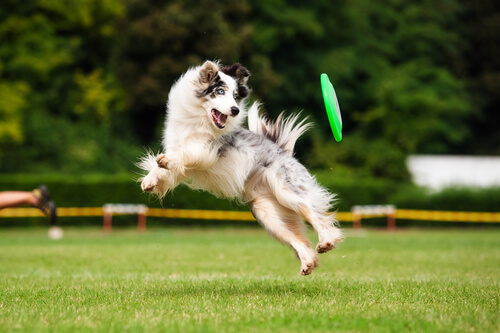How to Care for an Epileptic Dog


Written and verified by the lawyer Francisco María García
Caring for an epileptic dog is about providing a better quality of life. You are your dog’s best shot at keeping the disease from progressing and compromising his health even more.
Understanding Epilepsy
Idiopathic epilepsy is a genetic physical disorder that affects the neurons of the brain. Its only recognizable symptom is seizures. To clarify, epilepsy is not mental illness. Therefore, epileptic dogs do not have any learning difficulties or personality disorders. They are able to enjoy life and develop properly like other dogs.

The primary cause of the disorder remains unknown. But because it is largely genetic, some breeds are more susceptible, like German Shepherds, Labradors, Golden Retrievers, St. Bernard’s, Beagles, Irish Setters and Poodles.
What Are Epileptic Seizures?
It has been discovered that epileptic seizures are caused by excessive electrical activity in certain neurons. These cells become hyperactive and hyper-sensitive. This causes extreme excitement that often momentarily affects brain function.
That explains why people and animals lose motor coordination during epileptic seizures. There may also be involuntary movements, behavioral changes and loss of consciousness.
How to Diagnose Epilepsy in Dogs
Epilepsy develops silently in the animal’s body and is only apparent after the first seizure. An epileptic dog would usually have the first one between 6 months and 5 years old.
To begin with, other possible causes should be ruled out. Seizures can be secondary symptoms of more serious conditions. For example, these could include brain tumors, liver or heart failure, distemper, diabetes, trauma and poisoning.
When a dog has a seizure, call a veterinarian immediately. Early diagnosis is key.
Can Epilepsy in Dogs Be Treated or Prevented?
The truth is that there is no specific treatment or prevention for epilepsy. The causes are unknown. However, you can alleviate the symptoms and improve your dog’s quality of life.
It is common for traditional (non-holistic) vets to prescribe an anticonvulsant drug to prevent seizures from escalating. Veterinarians are the only professionals with the training to recommend treatment, which will vary according to the individual dog and how the disease has progressed.
How to Care for an Epileptic Dog
Epilepsy is not a lethal disease, but frequent seizures can harm a dog’s health. If your dog is dealing with it, it’s vital that you take care of him properly in order to reduce the risks of seizures.
Regular Visits to the Vet
Vet visits are the best preventive measure for all diseases. An epileptic dog should be checked every 6 months to see how things are progressing. The frequency and intensity of the dog’s seizures matter a lot to their health.
It’s also important to get blood tests twice a year, primarily for dogs on phenobarbital. High levels of this anticonvulsant in a dog’s bloodstream can cause obesity and liver damage.
Appropriate Medication
Naturally, it’s best to avoid large amounts of drugs. However, an epileptic dog needs the right medication in order to keep their body in balance. Seizures are enormously taxing for dogs, especially when they happen very often. Medication can reduce the frequency and intensity of seizures, which in turn protects the dog.
Lower Stress
It has been proven that epilepsy is closely linked to emotions. If a person or animal has a stressful day-to-day life or lives in a stressful environment, they’re more likely to have seizures.
A dog owner’s temperament plays into their dog’s behavior. Therefore, to reduce the dog’s stress, the owner must first change his own lifestyle. Though peace can’t overrule genes, it is indeed capable of decreasing a dog’s risk of seizures.
Basic Preventative Measures
Vaccination and deworming are basic preventive measures. Feeding your dog a good diet and encouraging regular physical activity will also help strengthen his immune system. In addition, these things will balance your dog’s metabolism and prevent obesity (and associated risks).

How to React When a Dog is Having an Epileptic Seizure
- Keep calm and act rationally.
- Place the animal on a flat, stable surface, which will prevent injury during the seizure. You can place him on a mat or pillows to make him more comfortable.
- Never try to take your dog’s tongue out of his mouth or put your hand inside a dog’s mouth. The animal may bite his own tongue or hurt you without meaning to.
- If your veterinarian prescribed an anticonvulsant, proceed as directed.
- Give the dog time to recover when the seizure ends. Provide him with a quiet environment to breathe and fully regain consciousness.
Caring for an epileptic dog is about providing a better quality of life. You are your dog’s best shot at keeping the disease from progressing and compromising his health even more.
Understanding Epilepsy
Idiopathic epilepsy is a genetic physical disorder that affects the neurons of the brain. Its only recognizable symptom is seizures. To clarify, epilepsy is not mental illness. Therefore, epileptic dogs do not have any learning difficulties or personality disorders. They are able to enjoy life and develop properly like other dogs.

The primary cause of the disorder remains unknown. But because it is largely genetic, some breeds are more susceptible, like German Shepherds, Labradors, Golden Retrievers, St. Bernard’s, Beagles, Irish Setters and Poodles.
What Are Epileptic Seizures?
It has been discovered that epileptic seizures are caused by excessive electrical activity in certain neurons. These cells become hyperactive and hyper-sensitive. This causes extreme excitement that often momentarily affects brain function.
That explains why people and animals lose motor coordination during epileptic seizures. There may also be involuntary movements, behavioral changes and loss of consciousness.
How to Diagnose Epilepsy in Dogs
Epilepsy develops silently in the animal’s body and is only apparent after the first seizure. An epileptic dog would usually have the first one between 6 months and 5 years old.
To begin with, other possible causes should be ruled out. Seizures can be secondary symptoms of more serious conditions. For example, these could include brain tumors, liver or heart failure, distemper, diabetes, trauma and poisoning.
When a dog has a seizure, call a veterinarian immediately. Early diagnosis is key.
Can Epilepsy in Dogs Be Treated or Prevented?
The truth is that there is no specific treatment or prevention for epilepsy. The causes are unknown. However, you can alleviate the symptoms and improve your dog’s quality of life.
It is common for traditional (non-holistic) vets to prescribe an anticonvulsant drug to prevent seizures from escalating. Veterinarians are the only professionals with the training to recommend treatment, which will vary according to the individual dog and how the disease has progressed.
How to Care for an Epileptic Dog
Epilepsy is not a lethal disease, but frequent seizures can harm a dog’s health. If your dog is dealing with it, it’s vital that you take care of him properly in order to reduce the risks of seizures.
Regular Visits to the Vet
Vet visits are the best preventive measure for all diseases. An epileptic dog should be checked every 6 months to see how things are progressing. The frequency and intensity of the dog’s seizures matter a lot to their health.
It’s also important to get blood tests twice a year, primarily for dogs on phenobarbital. High levels of this anticonvulsant in a dog’s bloodstream can cause obesity and liver damage.
Appropriate Medication
Naturally, it’s best to avoid large amounts of drugs. However, an epileptic dog needs the right medication in order to keep their body in balance. Seizures are enormously taxing for dogs, especially when they happen very often. Medication can reduce the frequency and intensity of seizures, which in turn protects the dog.
Lower Stress
It has been proven that epilepsy is closely linked to emotions. If a person or animal has a stressful day-to-day life or lives in a stressful environment, they’re more likely to have seizures.
A dog owner’s temperament plays into their dog’s behavior. Therefore, to reduce the dog’s stress, the owner must first change his own lifestyle. Though peace can’t overrule genes, it is indeed capable of decreasing a dog’s risk of seizures.
Basic Preventative Measures
Vaccination and deworming are basic preventive measures. Feeding your dog a good diet and encouraging regular physical activity will also help strengthen his immune system. In addition, these things will balance your dog’s metabolism and prevent obesity (and associated risks).

How to React When a Dog is Having an Epileptic Seizure
- Keep calm and act rationally.
- Place the animal on a flat, stable surface, which will prevent injury during the seizure. You can place him on a mat or pillows to make him more comfortable.
- Never try to take your dog’s tongue out of his mouth or put your hand inside a dog’s mouth. The animal may bite his own tongue or hurt you without meaning to.
- If your veterinarian prescribed an anticonvulsant, proceed as directed.
- Give the dog time to recover when the seizure ends. Provide him with a quiet environment to breathe and fully regain consciousness.
This text is provided for informational purposes only and does not replace consultation with a professional. If in doubt, consult your specialist.








